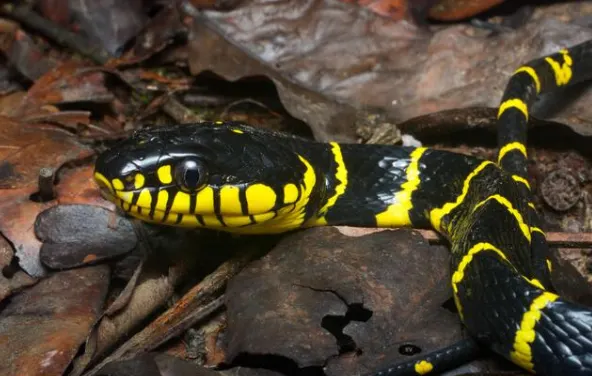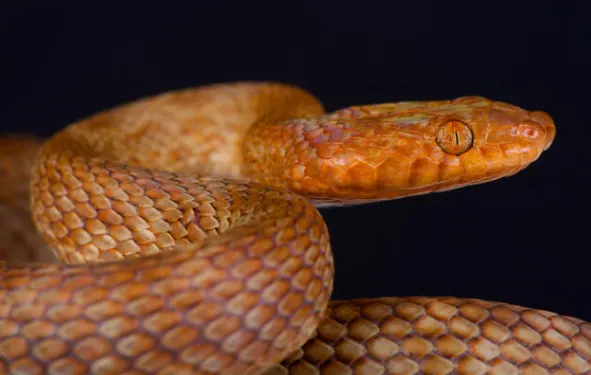The cat snake, a fascinating member of the Colubridae family, is known for its distinctive cat-like eyes and nocturnal hunting habits. Found across various regions in Africa, Asia, and Europe, this snake has adapted to a wide range of environments. Let’s explore the unique characteristics, behavior, and habitat of the cat snake.

Table of Contents
Quick Facts About the Cat Snake
- Scientific Classification:
- Kingdom: Animalia
- Phylum: Chordata
- Class: Reptilia
- Order: Squamata
- Family: Colubridae
- Conservation Status: Data Deficient to Least Concern, depending on the species
- Locations: Africa, Asia, Europe
- Diet: Omnivore, primarily feeding on rodents, lizards, geckos, frogs, and small birds
- Venomous: Yes, but only mildly venomous
- Aggression: Low
What Makes the Cat Snake Unique?
The cat snake is a nocturnal predator, meaning it is most active at night. Its eyes are one of its most distinctive features, resembling those of a cat with vertical, slit-like pupils that adjust to light levels. During the day, these pupils narrow to block out excess light, and at night, they widen to let in more light, enhancing the snake’s night vision.
5 Fascinating Facts About Cat Snakes
- Adaptable Eyes: The cat snake’s pupils adjust to the time of day, narrowing in daylight and expanding in darkness to improve its vision.
- Clutch Size: Depending on the species, a cat snake can lay up to 15 eggs, which may take several months to hatch.
- Prehensile Tail: Some species have a tail that helps them climb trees, allowing them to hunt and sleep in the branches.
- Venom Use: Although capable of producing venom, cat snakes don’t rely heavily on it for self-defense. They prefer to hide rather than confront threats.
- Sensory Skills: Like many other snakes, cat snakes use their sense of smell, vibrations, and chemical cues to navigate their environment.
Where Can You Find Cat Snakes?
Cat snakes are found across the Eastern Hemisphere, with different species inhabiting distinct regions:
- Eurasian Cat Snakes (Genus Telescopus): Found in southeastern Europe, southwestern Asia, and northern Africa.
- Old World Cat Snakes (Genus Boiga): Inhabit Southeast Asia and the Pacific region.
- African Cat Snakes: Prefer tropical rainforests and open woodlands in sub-Saharan Africa.
One well-known species in Europe is the Soosan snake, which ranges from the Balkans to the Caucasian Mountains.
Types of Cat Snakes
The cat snake group is diverse, with several genera:
- Boiga: The largest group, with about 35 species, native to Asia, Australia, and India.
- Telescopus: Includes around 12 species, found from north Eurasia to western Africa and Pakistan.
- Dipsadoboa: Known as the Cross-barred Tree Snake, this genus includes about 11 species found in Africa.
These genera all belong to the Colubrid family, the largest and most diverse snake family in the world.
What Does the Cat Snake Look Like?
Cat snakes vary widely in appearance, but they share some common traits:
- Size: Typically 2 to 4 feet long, but some species can grow up to 9 feet.
- Body: Long and stout with a triangular head distinct from the neck.
- Pupils: Vertical, cat-like pupils.
- Fangs: Short, rear-positioned fangs.
- Colors: Often green, brown, or yellow with black or brown markings. Some species, like the mangrove snake, have striking patterns, such as a black body with yellow rings.

How Dangerous Are Cat Snakes?
Despite their venomous nature, cat snakes are not particularly dangerous to humans. Their venom is mild, and they struggle to open their mouths wide enough to deliver a significant bite with their rear fangs. If bitten, the venom can cause mild symptoms like pain and swelling, but it’s generally not life-threatening. However, an allergic reaction could occur, so medical attention is advisable if bitten.
Behavior and Interaction with Humans
Cat snakes are generally timid and prefer to avoid confrontation. When encountered in the wild, they are more likely to flee than fight. They are not aggressive toward humans and rarely bite unless provoked. Due to their shy nature, cat snakes don’t make good pets, as they can become stressed and fearful when handled.
The cat snake is a remarkable example of nature’s adaptability. With its cat-like eyes, mild venom, and diverse habitat range, this snake is both fascinating and mysterious. While not a threat to humans, the cat snake plays an important role in its ecosystem, controlling populations of small animals and contributing to the biodiversity of its environment.
- Enchi Ball Python: A Unique and Stunning Morph of Python regius - March 27, 2025
- Emerald Tree Monitor: The Enigmatic Green Guardian of the Rainforest - March 26, 2025
- The Egyptian Cobra (Naja haje): A Fascinating Serpent - March 25, 2025
